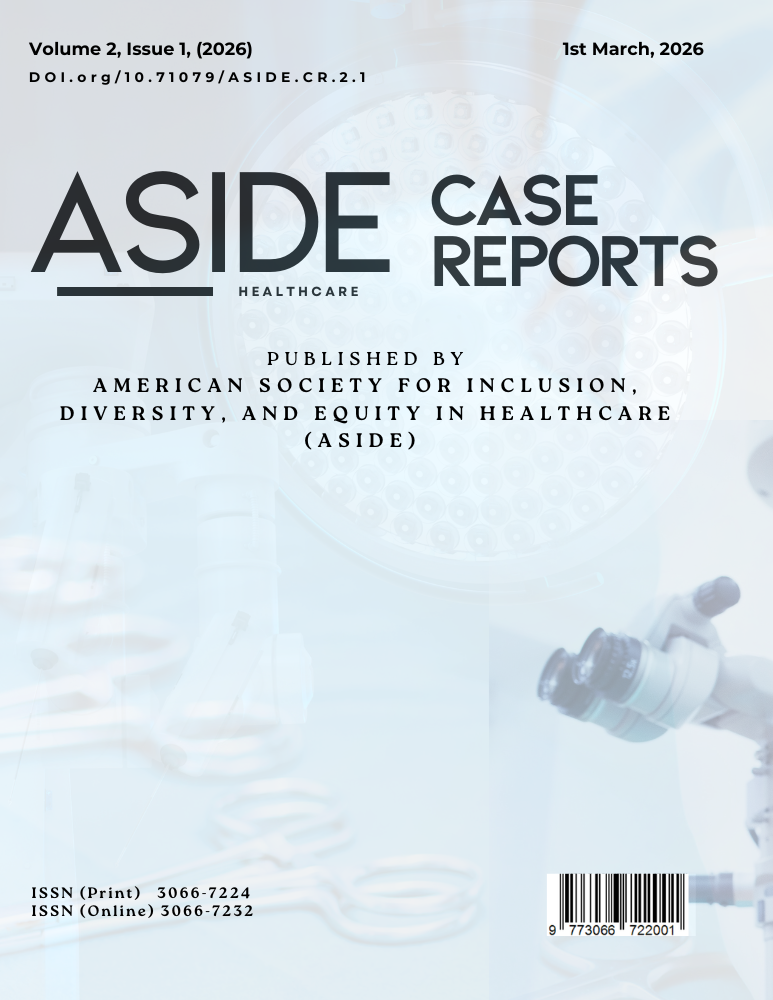Abstract
Pheochromocytoma is an uncommon adrenal medulla tumor that secretes catecholamines. It is usually a benign condition and is generally treated with adrenalectomy; in a small proportion of cases, however, it might return or spread. Pheochromocytoma is uncommon to recur or metastasize, meaning every reported case is clinically relevant.
A 46-year-old Caucasian woman initially presented with conventional catecholamine excess symptoms—refractory hypertension, palpitations, diaphoresis, and headaches. Imaging showed a sizable right adrenal mass; biochemical testing indicated very high plasma metanephrines. A medical decision was made to perform a right adrenalectomy; pathology confirmed a benign pheochromocytoma. After surgery, her symptoms went away, but she was missed for follow-up. Four years later, she came back with comparable symptoms; biochemical screening found increased metanephrines once more, and a computed tomography (CT) scan revealed local recurrence in the right adrenal bed. Notably, the CT also disclosed a lytic lesion in a lumbar vertebra and evidence of bone metastases from the pheochromocytoma. This instance highlights a rare situation in which a pheochromocytoma, initially thought to be innocuous, reoccurred with distant skeletal involvement.
In conclusion, a very rare, recurrent pheochromocytoma with bone metastases underscores the importance of continuous monitoring even after complete tumor removal. Early recognition of metastasis or relapse can significantly impact therapy and outcomes. This case highlights the necessity of ongoing follow-up in patients with pheochromocytoma and alerts individuals to potential late metastatic symptoms.
References
1. Yurt A, Arda MN, Vardar E. Metastatic pheochromocytoma of the thoracic spinal extradural space. Case report and review of the literature. Kobe J Med Sci. 2005: 49 [PMID: 16444096,
2. Kasliwal MK, Sharma MS, Vaishya S, Sharma BS. Metachronous pheochromocytoma metastasis to the upper dorsal spine-6-year survival. Spine J. 2008: 845 [PMID: 18024223, https://doi.org/10.1016/j.spinee.2007.06.004]
3. Liu S, Song A, Zhou X, Kong X, Li WA, Wang Y, Liu Y. Malignant pheochromocytoma with multiple vertebral metastases causing acute incomplete paralysis during pregnancy: Literature review with one case report. Medicine (Baltimore). 2017: e8535 [PMID: 29095319, https://doi.org/10.1097/MD.0000000000008535]
4. Chen H, Sippel RS, O'Dorisio MS, Vinik AI, Lloyd RV, Pacak K, North American Neuroendocrine Tumor S. The North American Neuroendocrine Tumor Society consensus guideline for the diagnosis and management of neuroendocrine tumors: pheochromocytoma, paraganglioma, and medullary thyroid cancer. Pancreas. 2010: 775 [PMID: 20664475, https://doi.org/10.1097/MPA.0b013e3181ebb4f0]
5. Guerrero MA, Schreinemakers JM, Vriens MR, Suh I, Hwang J, Shen WT, Gosnell J, Clark OH, Duh QY. Clinical spectrum of pheochromocytoma. J Am Coll Surg. 2009: 727 [PMID: 19959041, https://doi.org/10.1016/j.jamcollsurg.2009.09.022]
6. Neumann HPH, Young WF, Jr., Eng C. Pheochromocytoma and Paraganglioma. N Engl J Med. 2019: 552 [PMID: 31390501, https://doi.org/10.1056/NEJMra1806651]
7. Fishbein L, Merrill S, Fraker DL, Cohen DL, Nathanson KL. Inherited mutations in pheochromocytoma and paraganglioma: why all patients should be offered genetic testing. Ann Surg Oncol. 2013: 1444 [PMID: 23512077, https://doi.org/10.1245/s10434-013-2942-5]
8. Hamidi O, Young WF, Jr., Iniguez-Ariza NM, Kittah NE, Gruber L, Bancos C, Tamhane S, Bancos I. Malignant Pheochromocytoma and Paraganglioma: 272 Patients Over 55 Years. J Clin Endocrinol Metab. 2017: 3296 [PMID: 28605453, https://doi.org/10.1210/jc.2017-00992]
9. Hamidi O, Young WF, Jr., Gruber L, Smestad J, Yan Q, Ponce OJ, Prokop L, Murad MH, Bancos I. Outcomes of patients with metastatic phaeochromocytoma and paraganglioma: A systematic review and meta-analysis. Clin Endocrinol (Oxf). 2017: 440 [PMID: 28746746, https://doi.org/10.1111/cen.13434]
10. Ueda T, Oka N, Matsumoto A, Miyazaki H, Ohmura H, Kikuchi T, Nakayama M, Kato S, Imaizumi T. Pheochromocytoma presenting as recurrent hypotension and syncope. Intern Med. 2005: 222 [PMID: 15805711, https://doi.org/10.2169/internalmedicine.44.222]
11. Bravo EL. Pheochromocytoma: new concepts and future trends. Kidney Int. 1991: 544 [PMID: 1787652, https://doi.org/10.1038/ki.1991.244]
12. Lenders JW, Duh QY, Eisenhofer G, Gimenez-Roqueplo AP, Grebe SK, Murad MH, Naruse M, Pacak K, Young WF, Jr., Endocrine S. Pheochromocytoma and paraganglioma: an endocrine society clinical practice guideline. J Clin Endocrinol Metab. 2014: 1915 [PMID: 24893135, https://doi.org/10.1210/jc.2014-1498]
13. Clarke MR, Weyant RJ, Watson CG, Carty SE. Prognostic markers in pheochromocytoma. Hum Pathol. 1998: 522 [PMID: 9596278, https://doi.org/10.1016/s0046-8177(98)90070-3]
14. Darr R, Lenders JW, Hofbauer LC, Naumann B, Bornstein SR, Eisenhofer G. Pheochromocytoma - update on disease management. Ther Adv Endocrinol Metab. 2012: 11 [PMID: 23148191, https://doi.org/10.1177/2042018812437356]
15. Cui Y, Ma X, Gao Y, Chang X, Chen S, Lu L, Tong A. Local-Regional Recurrence of Pheochromocytoma/Paraganglioma: Characteristics, Risk Factors and Outcomes. Front Endocrinol (Lausanne). 2021: 762548 [PMID: 34899602, https://doi.org/10.3389/fendo.2021.762548]
16. Amar L, Servais A, Gimenez-Roqueplo AP, Zinzindohoue F, Chatellier G, Plouin PF. Year of diagnosis, features at presentation, and risk of recurrence in patients with pheochromocytoma or secreting paraganglioma. J Clin Endocrinol Metab. 2005: 2110 [PMID: 15644401, https://doi.org/10.1210/jc.2004-1398]
17. Plouin PF, Chatellier G, Fofol I, Corvol P. Tumor recurrence and hypertension persistence after successful pheochromocytoma operation. Hypertension. 1997: 1133 [PMID: 9149678, https://doi.org/10.1161/01.hyp.29.5.1133]
18. Ayala-Ramirez M, Palmer JL, Hofmann MC, de la Cruz M, Moon BS, Waguespack SG, Habra MA, Jimenez C. Bone metastases and skeletal-related events in patients with malignant pheochromocytoma and sympathetic paraganglioma. J Clin Endocrinol Metab. 2013: 1492 [PMID: 23436918, https://doi.org/10.1210/jc.2012-4231]
19. Dillon JS, Bushnell D, Laux DE. High-specific-activity (131)iodine-metaiodobenzylguanidine for therapy of unresectable pheochromocytoma and paraganglioma. Future Oncol. 2021: 1131 [PMID: 33506713, https://doi.org/10.2217/fon-2020-0625]
20. Tong A, Li M, Cui Y, Ma X, Wang H, Li Y. Temozolomide Is a Potential Therapeutic Tool for Patients With Metastatic Pheochromocytoma/Paraganglioma-Case Report and Review of the Literature. Front Endocrinol (Lausanne). 2020: 61 [PMID: 32132978, https://doi.org/10.3389/fendo.2020.00061]

This work is licensed under a Creative Commons Attribution 4.0 International License.
Copyright (c) 2025 ASIDE Case Reports


